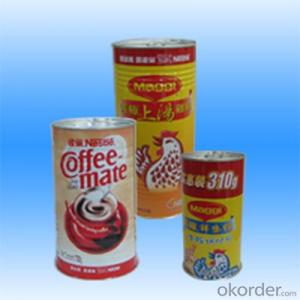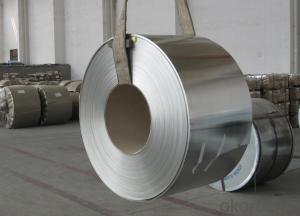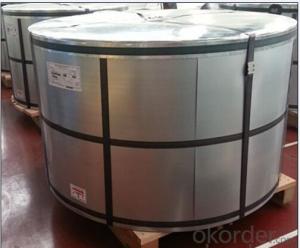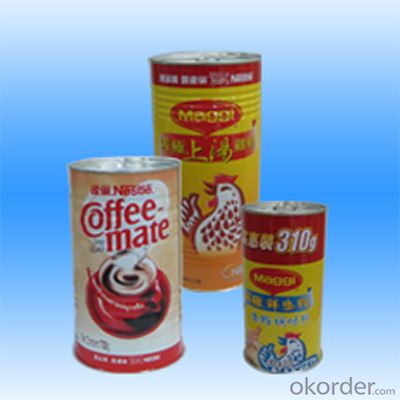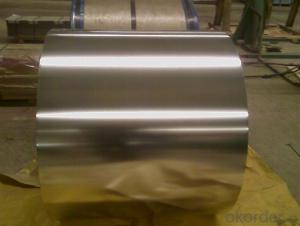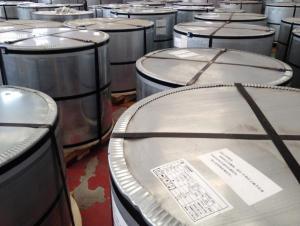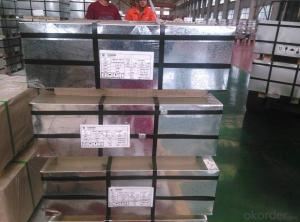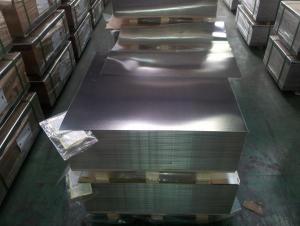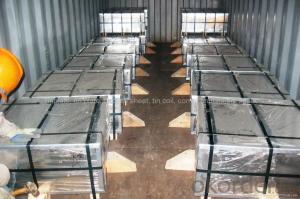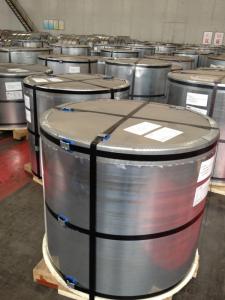CNBM Tinplate For Bottle Caps, DR, MR Material
- Loading Port:
- Tianjin
- Payment Terms:
- TT OR LC
- Min Order Qty:
- 15 m.t.
- Supply Capability:
- 50000 m.t./month
OKorder Service Pledge
OKorder Financial Service
You Might Also Like
1.Usage
Tinplate is widely used for making all types of containers, containing industrial usage such as paint can, oil can, aerosol cans etc., and food cans like milk powder cans, tomato paste can, dry food cans etc.
2. Quality
As a state owned company and a large tinplate supplier in China, our tinplate quality ranks 1st level in China, similar to Bao Steel, Posco etc.
3. Specification
standard: GB/T2520, JIS G3303, DIN EN10202
Material: MR /SPCC
Thickness available: 0.16-0.50MM
Width available: 600~1050MM
Temper grade: T1 – DR8
Tin coating: ordinary 2.8g/2.8g, 5.6g/5.6g and others
Package: sea worthy export package.
Applications: Tin can for chemicals & paint cans, industrial cans, food cans
4.our production equipments
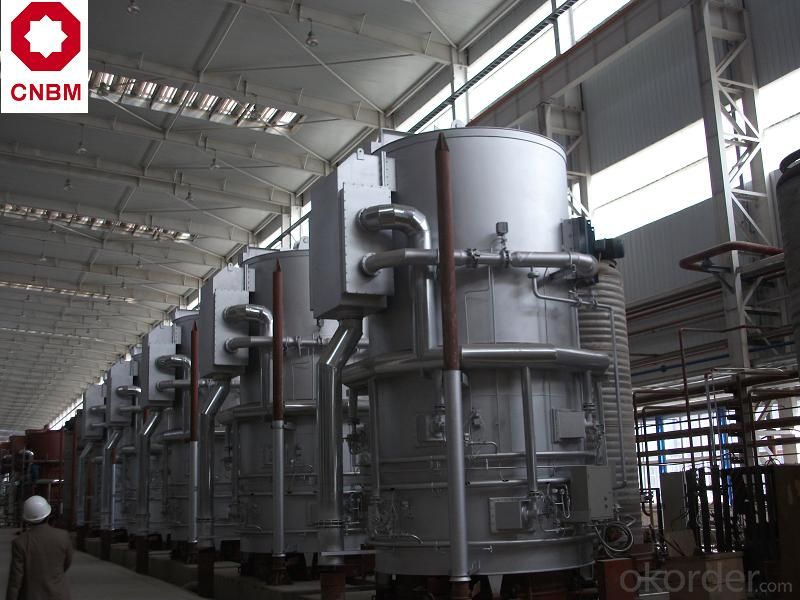
5. Our customers;
now our tinplate has been sold to more than 30 countries, including Europe countries, Gulf Area, South American, South Afric etc.
6. Our overseas markets:
Furthermore, in the year 2014, we have more than 10 overseas warehouses all over the word, located in KSA, UAE, Oman, Russia, Kuwait, Qatar, Oman, Chile, Brazil etc.
7. FAQ
a. what's the annual output?
about 500,000 tons per year.
b. where's the raw matrial from?
our hot rolled coil is purchased from Capital Steel and other state owned mill, with quite good quality.
c. how long is the delivery time?
normally for SPCC about 45~55 days, while 65~75 days for MR material
d. how to control the quality during production process?
inside our workshop, we have MES syestem. It realizes the optimization of the production procedure in the workshop. It could record each step of the whole production procedures, and if some problem appears, factory could easily found and take action, it’s quite helpful to monitor and control the quality.
- Q: How does tinplate contribute to the safety and integrity of packaged products?
- Tinplate contributes to the safety and integrity of packaged products through its excellent protective properties. The tin coating on the steel substrate acts as a barrier, preventing direct contact between the packaged product and the metal surface. This barrier helps to prevent corrosion, oxidation, and contamination of the product. Additionally, tinplate offers high strength and durability, ensuring that the package remains intact during handling and transportation, thereby safeguarding the contents from potential damage or spoilage.
- Q: How does tinplate compare to tin-free steel in terms of properties and applications?
- Tinplate and tin-free steel differ in terms of properties and applications. Tinplate has a thin tin coating on its surface, providing excellent corrosion resistance and a shiny appearance. It is commonly used in food and beverage packaging, as well as for decorative purposes. On the other hand, tin-free steel lacks the tin coating and is typically coated with other materials like chromium or polymer. It offers better paint adhesion and is often used in applications such as automotive parts, electrical appliances, and construction materials. Therefore, the choice between tinplate and tin-free steel depends on the specific requirements and intended applications.
- Q: What are the common sizes and shapes of tinplate products?
- Common sizes and shapes of tinplate products vary depending on their purpose and industry. However, some commonly seen sizes include cans ranging from small containers for food and beverages (such as soda cans) to larger ones for bulk products (such as paint cans). Tinplate products also come in various shapes, including rectangular, cylindrical, and irregular forms, to cater to different packaging needs and maximize storage efficiency.
- Q: How does tinplate packaging affect the shelf life of products?
- Tinplate packaging can significantly contribute to extending the shelf life of products. Tin is a non-reactive and corrosion-resistant material, which prevents the entry of moisture, air, and light, thereby protecting the contents from oxidation and spoilage. This barrier against external factors helps maintain the product's freshness, flavor, and nutritional value for a longer period. Additionally, tinplate packaging is durable and can withstand physical impacts, ensuring the integrity of the product throughout its shelf life.
- Q: Can tinplate packaging be used for medical products?
- Yes, tinplate packaging can be used for medical products. Tinplate is a durable and hygienic material that can effectively protect medical products from external contaminants and maintain their stability. It is commonly used for packaging items such as medical devices, pharmaceuticals, and sterile supplies.
- Q: What are the different methods of reusing tinplate packaging?
- There are several ways to reuse tinplate packaging. One common method is to repurpose the packaging for storing small items like buttons, jewelry, or crafting supplies. Tinplate packaging can also be used as decorative containers for plants, candles, or as unique gift boxes. Additionally, tinplate packaging can be recycled and used to create new products, reducing waste and promoting sustainability.
- Q: Both tinplate and stainless steel have corrosion protection
- Stainless steel is added in the iron, Cr, Ni and other corrosion-resistant materials, is fundamentally changed the anti-corrosion properties of materials.
- Q: How does tinplate contribute to the shelf life of canned products?
- Tinplate contributes to the shelf life of canned products by providing a protective barrier between the food and the metal can. This barrier prevents the food from coming into direct contact with the metal, reducing the risk of corrosion and contamination. Additionally, tinplate's resistance to moisture and oxygen helps to maintain the product's freshness and prevent spoilage over an extended period of time.
- Q: How does tinplate packaging contribute to food safety?
- Tinplate packaging contributes to food safety by providing a protective barrier that prevents contamination from external factors such as air, light, moisture, and microorganisms. It is resistant to corrosion and does not react with the food, ensuring the integrity and quality of the product. Additionally, tinplate packaging is tamper-proof, ensuring that the food remains safe until it reaches the consumer.
- Q: How does tinplate compare to aluminum packaging?
- Tinplate and aluminum packaging have their own set of advantages and disadvantages. Tinplate is generally more affordable and has good corrosion resistance, but it is heavier and less malleable than aluminum. On the other hand, aluminum is lightweight, highly malleable, and offers excellent barrier properties, but it is more expensive and can be prone to corrosion. Ultimately, the choice between tinplate and aluminum packaging depends on specific requirements such as cost, durability, and desired aesthetics.
Send your message to us
CNBM Tinplate For Bottle Caps, DR, MR Material
- Loading Port:
- Tianjin
- Payment Terms:
- TT OR LC
- Min Order Qty:
- 15 m.t.
- Supply Capability:
- 50000 m.t./month
OKorder Service Pledge
OKorder Financial Service
Similar products
Hot products
Hot Searches
Related keywords
